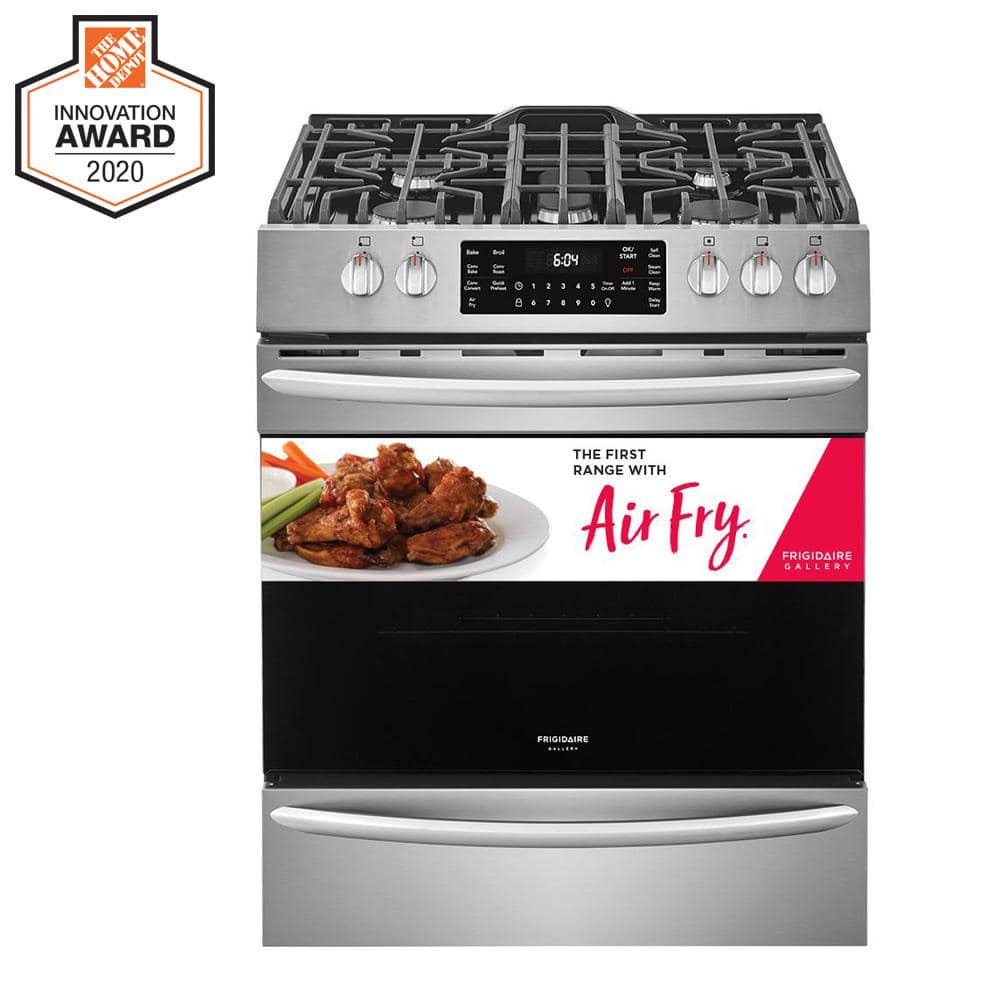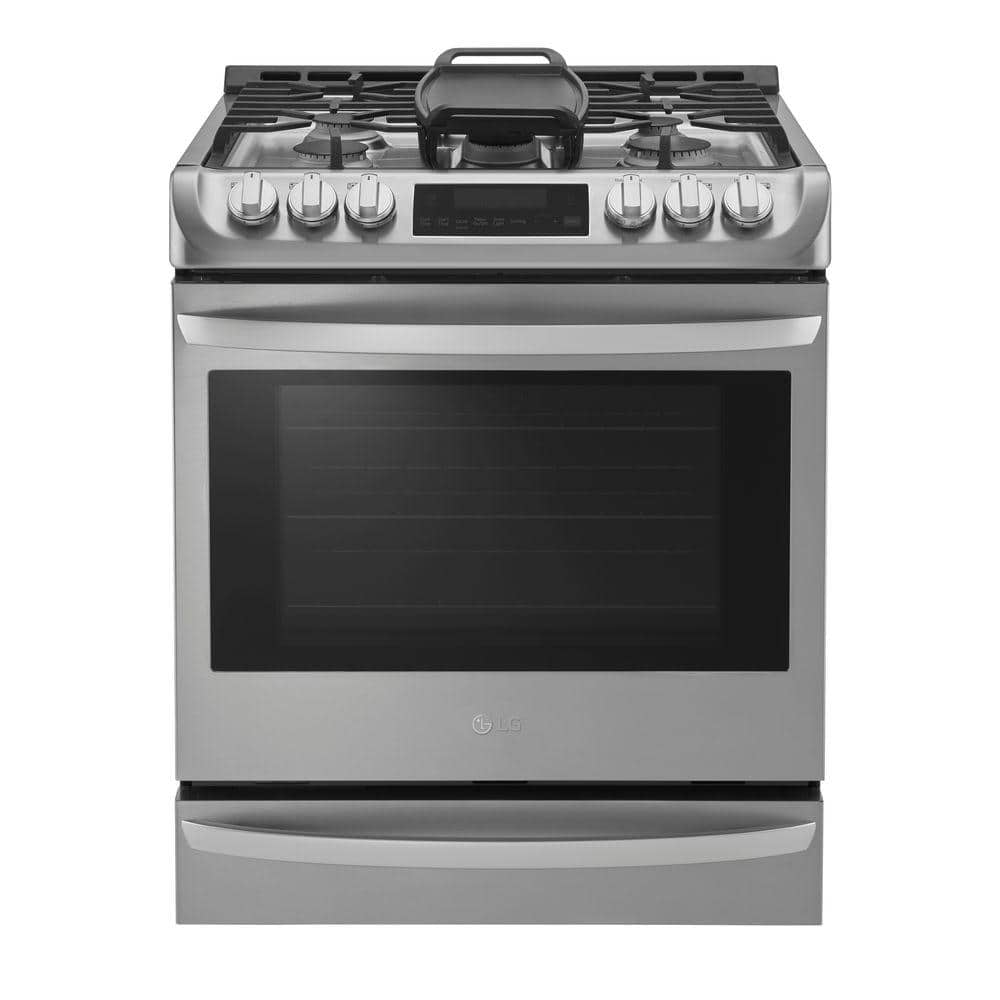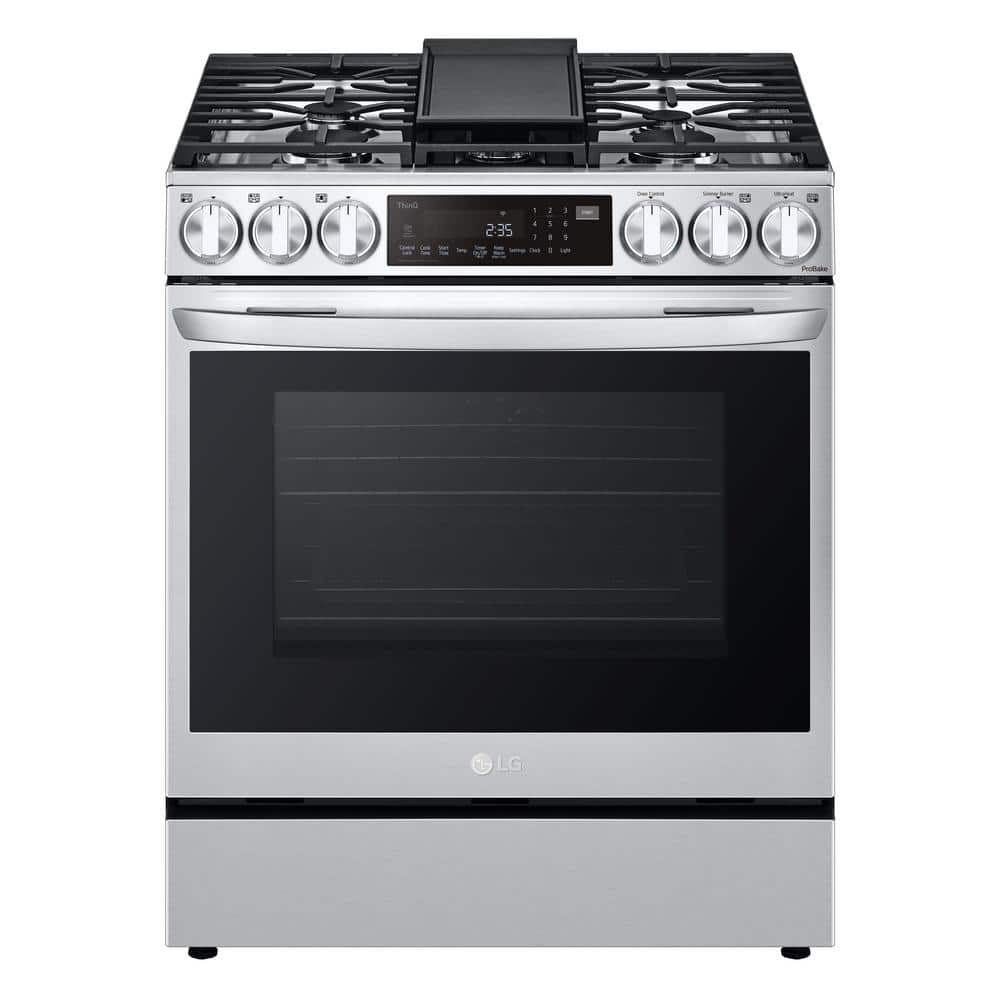GE 5.3 cu. ft. Slide-In Gas Range with Steam-Cleaning Oven in Stainless Steel
-
( 9 Reviews )Rated 4.56 out of 5 based on 9 customer ratings09
Edge-to-edge cooktop for cooking with pots and pans of all sizes. Steam cleaning the oven after cooking saves time and effort. Includes extra-large integrated nonstick griddle.
-
LG 6.3 cu. ft. Slide-In Gas Range with Probake Convection Oven in Stainless Steel
Rated 5.00 out of 510LG 6.3 cu. ft. Slide-In Gas Range with Probake Convection Oven in Stainless Steel
Rated 5.00 out of 510
GE Appliances provide up-to-date technology and exceptional quality to simplify the way you live. With a timeless appearance, this family of appliances is ideal for your family. And, coming from one of the most trusted names in America, you know that this entire selection of appliances is as advanced as it is practical.
- Edge-to-edge cooktop – a large, continuous cooking surface gives you extra room for pots and pans of all sizes and lets cookware move easily from burner to burner
- Two 15,000 BTU power boil burners – Steam your favorite veggies on one burner while searing a steak on the other
- Extra-large integrated non-stick griddle – cook up to 6 grilled cheeses at once on the industry’s largest integrated griddle
- 10,000 BTU oval burner – large oval fifth burner is ideal for griddle or odd-size cookware
- Steam clean – save time and effort by steam-cleaning the oven after cooking; no special water, kits or extra steps required
- In-oven broil – Healthy meals are hassle-free with in-oven broiling
- Smooth-glide storage drawer – Drawer opens and closes easily for instant access and extra storage
- 5.3 cu. ft. oven capacity – From roasting pans to Dutch ovens, large cookware is no problem for this range
- Finished sides – attractive look allows for installation flexibility in any kitchen
- Limited 1-year warranty entire appliance
Additional information
| Depth With Door(s) Open 90 Degrees (In.) | 47 |
|---|---|
| Oven Interior Depth x Height xWidth (in) | 19.5 x 19.5 x 24 |
| Product Depth x Height xWidth (in) | 29.25 x 36.25 x 30 |
| Range Size (in.) | 30 |
| Certifications and Listings | ADA Compliant,UL Listed |
| Manufacturer Warranty | Limited 1-year entire appliance |
3 (three) is a number, numeral and digit. It is the natural number following 2 and preceding 4, and is the smallest odd prime number and the only prime preceding a square number. It has religious and cultural significance in many societies.
5 (five) is a number, numeral and digit. It is the natural number, and cardinal number, following 4 and preceding 6, and is a prime number. It has garnered attention throughout history in part because distal extremities in humans typically contain five digits.
Five is the third-smallest prime number, and the second super-prime, since its prime index is prime. Notably, 5 is equal to the sum of the only consecutive primes 2 + 3 and it is the only number that is part of more than one pair of twin primes, (3, 5) and (5, 7), also making it the first balanced prime with equal-sized prime gaps above and below it (of 2). 5 is the first safe prime where for a prime is also prime (2), and the first good prime, since it is the first prime number whose square (25) is greater than the product of any two primes at the same number of positions before and after it in the sequence of primes (i.e., 3 × 7 = 21 and 11 × 2 = 22 are less than 25). 11, the fifth prime number, is the next good prime, that also forms the first pair of sexy primes with 5. More significantly, the fifth Heegner number that forms an imaginary quadratic field with unique factorization is also 11 (and the first repunit prime in decimal, a base in-which five is also the first non-trivial 1-automorphic number).
Five is also the second Fermat prime, and the third Mersenne prime exponent, as well as the fourth or fifth Fibonacci number. It is also an Eisenstein prime (like 11) with no imaginary part and real part of the form . It is the first congruent number, as well as the length of the hypotenuse of the smallest integer-sided right triangle, making part of the smallest Pythagorean triple (3, 4, 5). The regular five-sided pentagon is the first regular polygon that does not tile the plane with copies of itself, and it is the largest face that a regular three-dimensional regular Platonic solid can have, as represented in the regular dodecahedron. In general, a conic curve will require five points in the same way that two points are needed to determine a line.
Cleaning is the process of removing unwanted substances, such as dirt, infectious agents, and other impurities, from an object or environment. Cleaning is often performed for aesthetic, hygienic, functional, safety, or environmental protection purposes. Cleaning occurs in many different contexts, and uses many different methods. Several occupations are devoted to cleaning.
Gas is one of the four fundamental states of matter. The others are solid, liquid, and plasma. A pure gas may be made up of individual atoms (e.g. a noble gas like neon), elemental molecules made from one type of atom (e.g. oxygen), or compound molecules made from a variety of atoms (e.g. carbon dioxide). A gas mixture, such as air, contains a variety of pure gases. What distinguishes gases from liquids and solids is the vast separation of the individual gas particles. This separation usually makes a colorless gas invisible to the human observer.
The gaseous state of matter occurs between the liquid and plasma states, the latter of which provides the upper-temperature boundary for gases. Bounding the lower end of the temperature scale lie degenerative quantum gases which are gaining increasing attention. High-density atomic gases super-cooled to very low temperatures are classified by their statistical behavior as either Bose gases or Fermi gases. For a comprehensive listing of these exotic states of matter, see list of states of matter.
An oven is a tool which is used to expose materials to a hot environment. Ovens contain a hollow chamber and provide a means of heating the chamber in a controlled way. In use since antiquity, they have been used to accomplish a wide variety of tasks requiring controlled heating. Because they are used for a variety of purposes, there are many different types of ovens. These types differ depending on their intended purpose and based upon how they generate heat.
Ovens are often used for cooking, where they can be used to heat food to a desired temperature. Ovens are also used in the manufacturing of ceramics and pottery; these ovens are sometimes referred to as kilns. Metallurgical furnaces are ovens used in the manufacturing of metals, while glass furnaces are ovens used to produce glass.
There are many methods by which different types of ovens produce heat. Some ovens heat materials using the combustion of a fuel, such as wood, coal, or natural gas, while many employ electricity. Microwave ovens heat materials by exposing them to microwave radiation while electric ovens and electric furnaces heat materials using resistive heating. Some ovens use forced convection, the movement of gases inside the heating chamber, to enhance the heating process, or, in some cases, to change the properties of the material being heated, such as in the Bessemer method of steel production.
Stainless may refer to:
- Cleanliness, or the quality of being clean
- Stainless steel, a corrosion-resistant metal alloy
- Stainless Games, a British video game developer
- Stainless Broadcasting Company, a TV broadcaster based in Michigan, US
- Stainless Banner, the second national flag of the Confederate States of America
Steam is a substance containing water in the gas phase, often mixed with air and/or an aerosol of liquid water droplets. This may occur due to evaporation or due to boiling, where heat is applied until water reaches the enthalpy of vaporization. Steam that is saturated or superheated (water vapor) is invisible; however, wet steam, a visible mist or aerosol of water droplets, is often referred to as "steam".: 6
Water increases in volume by 1,700 times at standard temperature and pressure; this change in volume can be converted into mechanical work by steam engines such as reciprocating piston type engines and steam turbines, which are a sub-group of steam engines. Piston type steam engines played a central role in the Industrial Revolution and modern steam turbines are used to generate more than 80% of the world's electricity. If liquid water comes in contact with a very hot surface or depressurizes quickly below its vapor pressure, it can create a steam explosion.
Steel is an alloy of iron and carbon with improved strength and fracture resistance compared to other forms of iron. Because of its high tensile strength and low cost, steel is one of the most commonly manufactured materials in the world. Steel is used in buildings, as concrete reinforcing rods, in bridges, infrastructure, tools, ships, trains, cars, bicycles, machines, electrical appliances, furniture, and weapons.
Iron is always the main element in steel, but many other elements may be present or added. Stainless steels, which are resistant to corrosion and oxidation, typically need an additional 11% chromium.
Iron is the base metal of steel. Depending on the temperature, it can take two crystalline forms (allotropic forms): body-centred cubic and face-centred cubic. The interaction of the allotropes of iron with the alloying elements, primarily carbon, gives steel and cast iron their range of unique properties. In pure iron, the crystal structure has relatively little resistance to the iron atoms slipping past one another, and so pure iron is quite ductile, or soft and easily formed. In steel, small amounts of carbon, other elements, and inclusions within the iron act as hardening agents that prevent the movement of dislocations.
The carbon in typical steel alloys may contribute up to 2.14% of its weight. Varying the amount of carbon and many other alloying elements, as well as controlling their chemical and physical makeup in the final steel (either as solute elements, or as precipitated phases), impedes the movement of the dislocations that make pure iron ductile, and thus controls and enhances its qualities. These qualities include the hardness, quenching behaviour, need for annealing, tempering behaviour, yield strength, and tensile strength of the resulting steel. The increase in steel's strength compared to pure iron is possible only by reducing iron's ductility.
Steel was produced in bloomery furnaces for thousands of years, but its large-scale, industrial use began only after more efficient production methods were devised in the 17th century, with the introduction of the blast furnace and production of crucible steel. This was followed by the Bessemer process in England in the mid-19th century, and then by the open-hearth furnace. With the invention of the Bessemer process, a new era of mass-produced steel began. Mild steel replaced wrought iron. The German states were the major steel producers in Europe in the 19th century. American steel production was centered in Pittsburgh, Bethlehem, Pennsylvania, and Cleveland until the late 20th century.
Further refinements in the process, such as basic oxygen steelmaking (BOS), largely replaced earlier methods by further lowering the cost of production and increasing the quality of the final product. Today more than 1.6 billion tons of steel is produced annually. Modern steel is generally identified by various grades defined by assorted standards organizations. The modern steel industry is one of the largest manufacturing industries in the world, but also one of the most energy and greenhouse gas emission intense industries, contributing 8% of global emissions. However, steel is also very reusable: it is one of the world's most-recycled materials, with a recycling rate of over 60% globally.
With or WITH may refer to:
- With, a preposition in English
- Carl Johannes With (1877–1923), Danish doctor and arachnologist
- With (character), a character in D. N. Angel
- With (novel), a novel by Donald Harrington
- With (album), a 2014 album by TVXQ
- With (EP), a 2021 EP by Nam Woo-hyun






by Bob
It offers everything and is easy to use for any need.
by Cleo
Haven’t used the oven yet but I certainly like the stovetop. Burners work really well and spaced nicely apart. Appreciated knowing where to go online to obtain additional information or help, if necessary.
by Jeff
3 weeks in and no complaints. The quick boil burners work as promoted. Oven heats up quickly. Feels like a solid appliance
by John
Controls are easy to use. The integrated burners are easy to cleanup, and the temperature control is spot on.
by Nick
Had rang for about 4 months now and everything works great. The center griddle has been great for things like quesadillas and other grilled sandwiches. Only complain is that is oven is on for a while, covering on control panel starts to bubble up slightly, but returns to normal once oven is cool.
by James
Pretty good for a basic range. Standard with new build. Due to my cooking frequency I may have chosen a higher model.
by Paul
This units performs exactly as expected. I placed a thermometer in the oven to ensure temp was accurate, two years later still perfect. Cleans up nice. Good solid unit for the price. Note: that center griddle burner…don’t know how I ever got through life without one! Down side…gas smell when utilizing the oven. Took two or three hot (450 degree) bakes to get it to subside. I was told it is the interior enamel “baking in.”
by Chino
Great nice to cooking food I love going back to cooking more that is good.
by Steve
This stove fits perfectly in the width allotted for it in my kitchen but the housing connection for the gas in the rear of the stove stuck out and prevented the stove from being positioned against the wall. Instead, there is a 3 inch gap between the back of the stove and wall and accordingly the stove sticks out into the kitchen area. No help from the installers and none from Home Depot customer service so I am stuck with having to hire someone to come to fix the problem which is very lame. Be aware of this if you purchase this stove. Otherwise, we love how well the oven works. The surface scratches easily. Good luck!